Co.
-
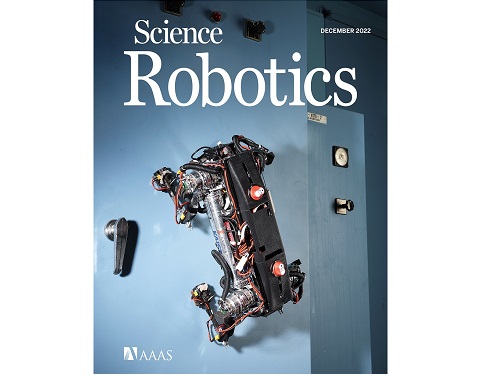 A Quick but Clingy Creepy-Crawler that will MARVEL You
Engineered by KAIST Mechanics, a quadrupedal robot climbs steel walls and crawls across metal ceilings at the fastest speed that the world has ever seen.
< Photo 1. (From left) KAIST ME Prof. Hae-Won Park, Ph.D. Student Yong Um, Ph.D. Student Seungwoo Hong >
- Professor Hae-Won Park's team at the Department of Mechanical Engineering developed a quadrupedal robot that can move at a high speed on ferrous walls and ceilings.
- It is expected to make a wide variety of contributions as it is to be used to conduct inspections and repairs of large steel structures such as ships, bridges, and transmission towers, offering an alternative to dangerous or risky activities required in hazardous environments while maintaining productivity and efficiency through automation and unmanning of such operations.
- The study was published as the cover paper of the December issue of Science Robotics.
KAIST (President Kwang Hyung Lee) announced on the 26th that a research team led by Professor Hae-Won Park of the Department of Mechanical Engineering developed a quadrupedal walking robot that can move at high speed on steel walls and ceilings named M.A.R.V.E.L. - rightly so as it is a Magnetically Adhesive Robot for Versatile and Expeditious Locomotion as described in their paper, “Agile and Versatile Climbing on Ferromagnetic Surfaces with a Quadrupedal Robot.” (DOI: 10.1126/scirobotics.add1017)
To make this happen, Professor Park's research team developed a foot pad that can quickly turn the magnetic adhesive force on and off while retaining high adhesive force even on an uneven surface through the use of the Electro-Permanent Magnet (EPM), a device that can magnetize and demagnetize an electromagnet with little power, and the Magneto-Rheological Elastomer (MRE), an elastic material made by mixing a magnetic response factor, such as iron powder, with an elastic material, such as rubber, which they mounted on a small quadrupedal robot they made in-house, at their own laboratory. These walking robots are expected to be put into a wide variety of usage, including being programmed to perform inspections, repairs, and maintenance tasks on large structures made of steel, such as ships, bridges, transmission towers, large storage areas, and construction sites.
This study, in which Seungwoo Hong and Yong Um of the Department of Mechanical Engineering participated as co-first authors, was published as the cover paper in the December issue of Science Robotics.
< Image on the Cover of 2022 December issue of Science Robotics >
Existing wall-climbing robots use wheels or endless tracks, so their mobility is limited on surfaces with steps or irregularities. On the other hand, walking robots for climbing can expect improved mobility in obstacle terrain, but have disadvantages in that they have significantly slower moving speeds or cannot perform various movements.
In order to enable fast movement of the walking robot, the sole of the foot must have strong adhesion force and be able to control the adhesion to quickly switch from sticking to the surface or to be off of it. In addition, it is necessary to maintain the adhesion force even on a rough or uneven surface.
To solve this problem, the research team used the EPM and MRE for the first time in designing the soles of walking robots. An EPM is a magnet that can turn on and off the electromagnetic force with a short current pulse. Unlike general electromagnets, it has the advantage that it does not require energy to maintain the magnetic force. The research team proposed a new EPM with a rectangular structure arrangement, enabling faster switching while significantly lowering the voltage required for switching compared to existing electromagnets.
In addition, the research team was able to increase the frictional force without significantly reducing the magnetic force of the sole by covering the sole with an MRE. The proposed sole weighs only 169 g, but provides a vertical gripping force of about *535 Newtons (N) and a frictional force of 445 N, which is sufficient gripping force for a quadrupedal robot weighing 8 kg.
* 535 N converted to kg is 54.5 kg, and 445 N is 45.4 kg. In other words, even if an external force of up to 54.5 kg in the vertical direction and up to 45.4 kg in the horizontal direction is applied (or even if a corresponding weight is hung), the sole of the foot does not come off the steel plate.
MARVEL climbed up a vertical wall at high speed at a speed of 70 cm per second, and was able to walk while hanging upside down from the ceiling at a maximum speed of 50 cm per second. This is the world's fastest speed for a walking climbing robot. In addition, the research team demonstrated that the robot can climb at a speed of up to 35 cm even on a surface that is painted, dirty with dust and the rust-tainted surfaces of water tanks, proving the robot's performance in a real environment. It was experimentally demonstrated that the robot not only exhibited high speed, but also can switch from floor to wall and from wall to ceiling, and overcome 5-cm high obstacles protruding from walls without difficulty.
The new climbing quadrupedal robot is expected to be widely used for inspection, repair, and maintenance of large steel structures such as ships, bridges, transmission towers, oil pipelines, large storage areas, and construction sites. As the works required in these places involves risks such as falls, suffocation and other accidents that may result in serious injuries or casualties, the need for automation is of utmost urgency.
One of the first co-authors of the paper, a Ph.D. student, Yong Um of KAIST’s Department of Mechanical Engineering, said, "By the use of the magnetic soles made up of the EPM and MRE and the non-linear model predictive controller suitable for climbing, the robot can speedily move through a variety of ferromagnetic surfaces including walls and ceilings, not just level grounds. We believe this would become a cornerstone that will expand the mobility and the places of pedal-mobile robots can venture into." He added, “These robots can be put into good use in executing dangerous and difficult tasks on steel structures in places like the shipbuilding yards.”
This research was carried out with support from the National Research Foundation of Korea's Basic Research in Science & Engineering Program for Mid-Career Researchers and Korea Shipbuilding & Offshore Engineering Co., Ltd..
< Figure 1. The quadrupedal robot (MARVEL) walking over various ferrous surfaces. (A) vertical wall (B) ceiling. (C) over obstacles on a vertical wall (D) making floor-to-wall and wall-to-ceiling transitions (E) moving over a storage tank (F) walking on a wall with a 2-kg weight and over a ceiling with a 3-kg load. >
< Figure 2. Description of the magnetic foot (A) Components of the magnet sole: ankle, Square Eletro-Permanent Magnet(S-EPM), MRE footpad. (B) Components of the S-EPM and MRE footpad. (C) Working principle of the S-EPM. When the magnetization direction is aligned as shown in the left figure, magnetic flux comes out of the keeper and circulates through the steel plate, generating holding force (ON state). Conversely, if the magnetization direction is aligned as shown in the figure on the right, the magnetic flux circulates inside the S-EPM and the holding force disappears (OFF state). >
Video Introduction: Agile and versatile climbing on ferromagnetic surfaces with a quadrupedal robot - YouTube
2022.12.30 View 18680
A Quick but Clingy Creepy-Crawler that will MARVEL You
Engineered by KAIST Mechanics, a quadrupedal robot climbs steel walls and crawls across metal ceilings at the fastest speed that the world has ever seen.
< Photo 1. (From left) KAIST ME Prof. Hae-Won Park, Ph.D. Student Yong Um, Ph.D. Student Seungwoo Hong >
- Professor Hae-Won Park's team at the Department of Mechanical Engineering developed a quadrupedal robot that can move at a high speed on ferrous walls and ceilings.
- It is expected to make a wide variety of contributions as it is to be used to conduct inspections and repairs of large steel structures such as ships, bridges, and transmission towers, offering an alternative to dangerous or risky activities required in hazardous environments while maintaining productivity and efficiency through automation and unmanning of such operations.
- The study was published as the cover paper of the December issue of Science Robotics.
KAIST (President Kwang Hyung Lee) announced on the 26th that a research team led by Professor Hae-Won Park of the Department of Mechanical Engineering developed a quadrupedal walking robot that can move at high speed on steel walls and ceilings named M.A.R.V.E.L. - rightly so as it is a Magnetically Adhesive Robot for Versatile and Expeditious Locomotion as described in their paper, “Agile and Versatile Climbing on Ferromagnetic Surfaces with a Quadrupedal Robot.” (DOI: 10.1126/scirobotics.add1017)
To make this happen, Professor Park's research team developed a foot pad that can quickly turn the magnetic adhesive force on and off while retaining high adhesive force even on an uneven surface through the use of the Electro-Permanent Magnet (EPM), a device that can magnetize and demagnetize an electromagnet with little power, and the Magneto-Rheological Elastomer (MRE), an elastic material made by mixing a magnetic response factor, such as iron powder, with an elastic material, such as rubber, which they mounted on a small quadrupedal robot they made in-house, at their own laboratory. These walking robots are expected to be put into a wide variety of usage, including being programmed to perform inspections, repairs, and maintenance tasks on large structures made of steel, such as ships, bridges, transmission towers, large storage areas, and construction sites.
This study, in which Seungwoo Hong and Yong Um of the Department of Mechanical Engineering participated as co-first authors, was published as the cover paper in the December issue of Science Robotics.
< Image on the Cover of 2022 December issue of Science Robotics >
Existing wall-climbing robots use wheels or endless tracks, so their mobility is limited on surfaces with steps or irregularities. On the other hand, walking robots for climbing can expect improved mobility in obstacle terrain, but have disadvantages in that they have significantly slower moving speeds or cannot perform various movements.
In order to enable fast movement of the walking robot, the sole of the foot must have strong adhesion force and be able to control the adhesion to quickly switch from sticking to the surface or to be off of it. In addition, it is necessary to maintain the adhesion force even on a rough or uneven surface.
To solve this problem, the research team used the EPM and MRE for the first time in designing the soles of walking robots. An EPM is a magnet that can turn on and off the electromagnetic force with a short current pulse. Unlike general electromagnets, it has the advantage that it does not require energy to maintain the magnetic force. The research team proposed a new EPM with a rectangular structure arrangement, enabling faster switching while significantly lowering the voltage required for switching compared to existing electromagnets.
In addition, the research team was able to increase the frictional force without significantly reducing the magnetic force of the sole by covering the sole with an MRE. The proposed sole weighs only 169 g, but provides a vertical gripping force of about *535 Newtons (N) and a frictional force of 445 N, which is sufficient gripping force for a quadrupedal robot weighing 8 kg.
* 535 N converted to kg is 54.5 kg, and 445 N is 45.4 kg. In other words, even if an external force of up to 54.5 kg in the vertical direction and up to 45.4 kg in the horizontal direction is applied (or even if a corresponding weight is hung), the sole of the foot does not come off the steel plate.
MARVEL climbed up a vertical wall at high speed at a speed of 70 cm per second, and was able to walk while hanging upside down from the ceiling at a maximum speed of 50 cm per second. This is the world's fastest speed for a walking climbing robot. In addition, the research team demonstrated that the robot can climb at a speed of up to 35 cm even on a surface that is painted, dirty with dust and the rust-tainted surfaces of water tanks, proving the robot's performance in a real environment. It was experimentally demonstrated that the robot not only exhibited high speed, but also can switch from floor to wall and from wall to ceiling, and overcome 5-cm high obstacles protruding from walls without difficulty.
The new climbing quadrupedal robot is expected to be widely used for inspection, repair, and maintenance of large steel structures such as ships, bridges, transmission towers, oil pipelines, large storage areas, and construction sites. As the works required in these places involves risks such as falls, suffocation and other accidents that may result in serious injuries or casualties, the need for automation is of utmost urgency.
One of the first co-authors of the paper, a Ph.D. student, Yong Um of KAIST’s Department of Mechanical Engineering, said, "By the use of the magnetic soles made up of the EPM and MRE and the non-linear model predictive controller suitable for climbing, the robot can speedily move through a variety of ferromagnetic surfaces including walls and ceilings, not just level grounds. We believe this would become a cornerstone that will expand the mobility and the places of pedal-mobile robots can venture into." He added, “These robots can be put into good use in executing dangerous and difficult tasks on steel structures in places like the shipbuilding yards.”
This research was carried out with support from the National Research Foundation of Korea's Basic Research in Science & Engineering Program for Mid-Career Researchers and Korea Shipbuilding & Offshore Engineering Co., Ltd..
< Figure 1. The quadrupedal robot (MARVEL) walking over various ferrous surfaces. (A) vertical wall (B) ceiling. (C) over obstacles on a vertical wall (D) making floor-to-wall and wall-to-ceiling transitions (E) moving over a storage tank (F) walking on a wall with a 2-kg weight and over a ceiling with a 3-kg load. >
< Figure 2. Description of the magnetic foot (A) Components of the magnet sole: ankle, Square Eletro-Permanent Magnet(S-EPM), MRE footpad. (B) Components of the S-EPM and MRE footpad. (C) Working principle of the S-EPM. When the magnetization direction is aligned as shown in the left figure, magnetic flux comes out of the keeper and circulates through the steel plate, generating holding force (ON state). Conversely, if the magnetization direction is aligned as shown in the figure on the right, the magnetic flux circulates inside the S-EPM and the holding force disappears (OFF state). >
Video Introduction: Agile and versatile climbing on ferromagnetic surfaces with a quadrupedal robot - YouTube
2022.12.30 View 18680 -
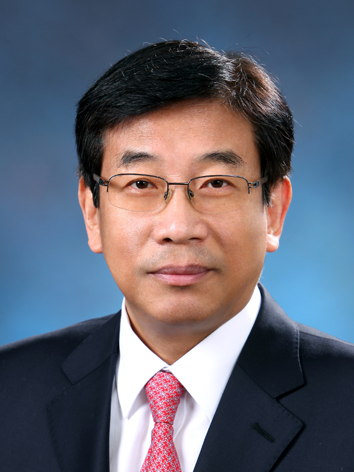 Professor Jae-Kyu Lee Elected to Head the Association for Information Systems
Jae Kyu Lee, HHI (Hyundai Heavy Industries, Co., Ltd.) Chair Professor, College of Business at KAIST, was elected to lead the world major academic society, Association for Information Systems (AIS), from July 2015 to June 2016. Professor Lee will be the first Korean to serve the organization as president. From July 2014 to June 2015, he will serve as president-elect.
Currently, Professor Lee is the Director of EEWS (Energy, Environment, Water, and Sustainability) Research Center at KAIST, focusing on research and development in finding solutions to critical issues facing humanity. He also played a pivotal role in the conclusion of a memorandum of understanding between HHI and KAIST in June 2013 to establish HHI-KAIST EEWS Research Center within the KAIST campus.
The AIS is the premier professional association for individuals and organizations who lead the research, teaching, practice, and study of information systems worldwide.
A news article on his appointment:
Asian Scientist, May 16, 2014
Korean Engineer To Lead The Association For Information Systems
http://www.asianscientist.com/academia/korean-engineer-lead-association-information-systems-2014/
2014.05.19 View 12469
Professor Jae-Kyu Lee Elected to Head the Association for Information Systems
Jae Kyu Lee, HHI (Hyundai Heavy Industries, Co., Ltd.) Chair Professor, College of Business at KAIST, was elected to lead the world major academic society, Association for Information Systems (AIS), from July 2015 to June 2016. Professor Lee will be the first Korean to serve the organization as president. From July 2014 to June 2015, he will serve as president-elect.
Currently, Professor Lee is the Director of EEWS (Energy, Environment, Water, and Sustainability) Research Center at KAIST, focusing on research and development in finding solutions to critical issues facing humanity. He also played a pivotal role in the conclusion of a memorandum of understanding between HHI and KAIST in June 2013 to establish HHI-KAIST EEWS Research Center within the KAIST campus.
The AIS is the premier professional association for individuals and organizations who lead the research, teaching, practice, and study of information systems worldwide.
A news article on his appointment:
Asian Scientist, May 16, 2014
Korean Engineer To Lead The Association For Information Systems
http://www.asianscientist.com/academia/korean-engineer-lead-association-information-systems-2014/
2014.05.19 View 12469 -
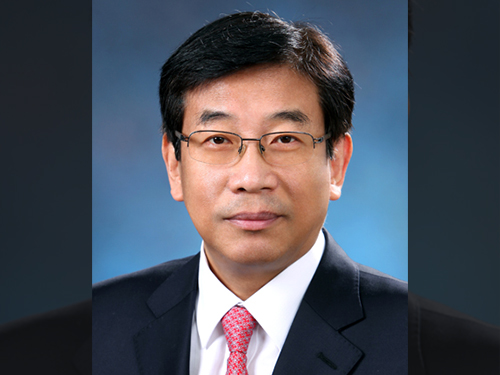 Professor Jae-Kyu Lee Elected to Head the Association for Information Systems
Jae Kyu Lee, HHI (Hyundai Heavy Industries, Co., Ltd.) Chair Professor, College of Business at KAIST, has been elected to lead the world major academic society, Association for Information Systems (AIS), from July 2015 to June 2016. Professor Lee will be the first Korean to serve the organization as president. From July 2014 to June 2015, he will serve as president-elect.
Currently, Professor Lee is the Director of EEWS (Energy, Environment, Water, and Sustainability) Research Center at KAIST, focusing on research and development in finding solutions to critical issues facing humanity. He also played a pivotal role in the conclusion of a memorandum of understanding between HHI and KAIST in June 2013 to establish HHI-KAIST EEWS Research Center within the KAIST campus.
The AIS is the premier professional association for individuals and organizations who lead the research, teaching, practice, and study of information systems worldwide.
2014.05.14 View 11476
Professor Jae-Kyu Lee Elected to Head the Association for Information Systems
Jae Kyu Lee, HHI (Hyundai Heavy Industries, Co., Ltd.) Chair Professor, College of Business at KAIST, has been elected to lead the world major academic society, Association for Information Systems (AIS), from July 2015 to June 2016. Professor Lee will be the first Korean to serve the organization as president. From July 2014 to June 2015, he will serve as president-elect.
Currently, Professor Lee is the Director of EEWS (Energy, Environment, Water, and Sustainability) Research Center at KAIST, focusing on research and development in finding solutions to critical issues facing humanity. He also played a pivotal role in the conclusion of a memorandum of understanding between HHI and KAIST in June 2013 to establish HHI-KAIST EEWS Research Center within the KAIST campus.
The AIS is the premier professional association for individuals and organizations who lead the research, teaching, practice, and study of information systems worldwide.
2014.05.14 View 11476 -
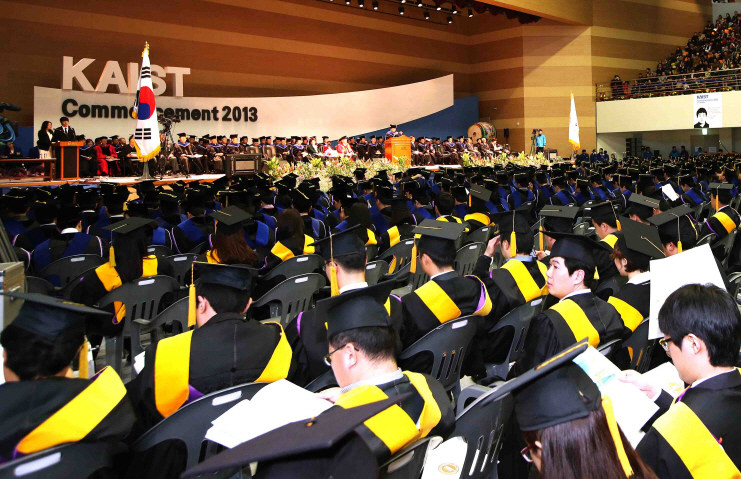 2013 Graduation Ceremony Held on February 22
KAIST held a graduation ceremony for the year 2013 at Ryu Keun-Chul Sports Complex on February 22nd.
A total of 2,475 academic degrees were awarded this day, including 482 doctoral degrees, 1,153 master’s degrees, 838 bachelor’s degrees, and two honorary doctorates to Dr. Han Seung-Soo, a former prime minister of South Korea, and Lee Soo-young, the chairwoman of Kwang Won Industrial Co. Ltd. This commencement made KAIST to have turned out overall 46,117 talented graduates – 9,383 doctorates, 23,941 master’s degrees, and 12,793 bachelor’s degrees – to the fields of science and technology since its establishment in 1971.
The Minister of Education and Science Technology Award, which is for the student receiving bachelor’s degree with the highest academic performance, was given to Seung-Uk Jang from the Department of Mathematical Sciences. In addition, the Chairman of the KAIST Board of Trustees Award was given to Chi-Heon Kwon from the Department of Chemistry, KAIST Presidential Award to Yong-Jin Park from the Department of Chemical and Biomolecular Engineering, President of Alumni Association Award to Bong-Soo Choi from the Department Electrical Engineering, and School Supporting Association’s Award to Bo-Kyung Kim from the Bio and Brain Engineering Department.
“Climate changes due to humanity’s economic activities are threatening crucial resources such as water, food, and energy security,” said Former Prime Minister Han Seung-Soo, who received an honorary doctorate at the commencement ceremony. “Please try to solve the greatest issues that human society is facing,” he entreated in his congratulatory message.
“Use the excellent education that you have received at KAIST wisely with good purpose and ethics,” also congratulated President Suh Nam-Pyo. “I hope the graduating students of KAIST to become global leaders in the near future,” he said to the graduates entering the society.
“It was a great honor to contribute as the president of KAIST for almost 7 years, which has been the most challenging and worthwhile time in my life,” he delivered words of gratitude to all members of KAIST. “I appreciate everyone’s efforts for KAIST to develop so far.”
President Suh completed his duty as the fourteenth president of KAIST with the ceremony and returned to the United States on the 25th.
2013.02.26 View 10121
2013 Graduation Ceremony Held on February 22
KAIST held a graduation ceremony for the year 2013 at Ryu Keun-Chul Sports Complex on February 22nd.
A total of 2,475 academic degrees were awarded this day, including 482 doctoral degrees, 1,153 master’s degrees, 838 bachelor’s degrees, and two honorary doctorates to Dr. Han Seung-Soo, a former prime minister of South Korea, and Lee Soo-young, the chairwoman of Kwang Won Industrial Co. Ltd. This commencement made KAIST to have turned out overall 46,117 talented graduates – 9,383 doctorates, 23,941 master’s degrees, and 12,793 bachelor’s degrees – to the fields of science and technology since its establishment in 1971.
The Minister of Education and Science Technology Award, which is for the student receiving bachelor’s degree with the highest academic performance, was given to Seung-Uk Jang from the Department of Mathematical Sciences. In addition, the Chairman of the KAIST Board of Trustees Award was given to Chi-Heon Kwon from the Department of Chemistry, KAIST Presidential Award to Yong-Jin Park from the Department of Chemical and Biomolecular Engineering, President of Alumni Association Award to Bong-Soo Choi from the Department Electrical Engineering, and School Supporting Association’s Award to Bo-Kyung Kim from the Bio and Brain Engineering Department.
“Climate changes due to humanity’s economic activities are threatening crucial resources such as water, food, and energy security,” said Former Prime Minister Han Seung-Soo, who received an honorary doctorate at the commencement ceremony. “Please try to solve the greatest issues that human society is facing,” he entreated in his congratulatory message.
“Use the excellent education that you have received at KAIST wisely with good purpose and ethics,” also congratulated President Suh Nam-Pyo. “I hope the graduating students of KAIST to become global leaders in the near future,” he said to the graduates entering the society.
“It was a great honor to contribute as the president of KAIST for almost 7 years, which has been the most challenging and worthwhile time in my life,” he delivered words of gratitude to all members of KAIST. “I appreciate everyone’s efforts for KAIST to develop so far.”
President Suh completed his duty as the fourteenth president of KAIST with the ceremony and returned to the United States on the 25th.
2013.02.26 View 10121 -
 KAIST to Support R&D Plans of Mid-Small Sized Enterprises
KAIST signed a MOU for the ‘Support for R&D Plans for Mid-Small Sized Firms’ with the Small and Medium Business Conference and Korea South-East Power Co. Ltd.
KAIST and Korea South-East Power Co. Ltd. will now be improving their cooperation on supporting R&D plans to help the technology development and commercialization for Small and Medium Businesses.
Korea South-East Power Co. Ltd. will now select 20 best qualified firms out of its 300 cooperating firms and suggest them as candidates to KAIST Business membership System.
The suggested firms will be given: ▲Strategy R&D Planning ▲Consult Difficult Technology ▲Provide Information on Research Labs and Researchers among other various programs.
The firms participating in the KAIST Business membership System will be able to minimize risk and increase its possibility for success on Development Technology.
KAIST Business membership System is a program provided to firms for a membership fee, in order to create technological innovation and strengthen cooperation between university and industry.
2012.01.31 View 10004
KAIST to Support R&D Plans of Mid-Small Sized Enterprises
KAIST signed a MOU for the ‘Support for R&D Plans for Mid-Small Sized Firms’ with the Small and Medium Business Conference and Korea South-East Power Co. Ltd.
KAIST and Korea South-East Power Co. Ltd. will now be improving their cooperation on supporting R&D plans to help the technology development and commercialization for Small and Medium Businesses.
Korea South-East Power Co. Ltd. will now select 20 best qualified firms out of its 300 cooperating firms and suggest them as candidates to KAIST Business membership System.
The suggested firms will be given: ▲Strategy R&D Planning ▲Consult Difficult Technology ▲Provide Information on Research Labs and Researchers among other various programs.
The firms participating in the KAIST Business membership System will be able to minimize risk and increase its possibility for success on Development Technology.
KAIST Business membership System is a program provided to firms for a membership fee, in order to create technological innovation and strengthen cooperation between university and industry.
2012.01.31 View 10004 -
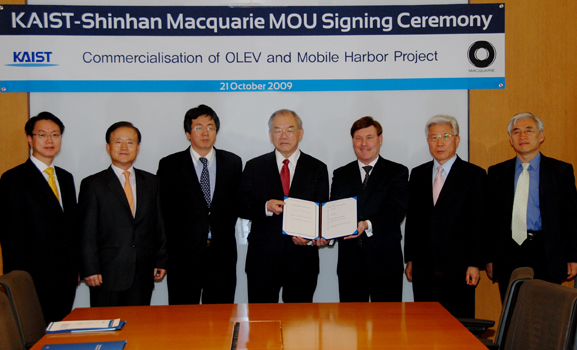 KAIST Signs MOU with Macquarie for Cooperation in Green Growth Projects
KAIST and Shinhan Macquarie Financial Advisory Co. have reached an agreement for cooperation in the development and commercialization of the KAIST-led two national green growth projects, On-line Electric Vehicle (OLEV) and Mobile Harbor (MH) programs, university authorities said.
KAIST President Nam-Pyo Suh signed a memorandum of understanding with John Walker, Chairman of Macquarie Group of Companies in Korea, and Woo-Gon Hwang, Representative Director of Shinhan Macquarie Financial Advisory Co. on Wednesday, Oct. 21.
Under the agreement, KAIST and Macquarie will cooperate in developing an optimal business structure for a rapid commercialization of OLEV and MH. Specifically, Shinhan Macquarie Financial Advisory will provide financial advice, including basis financial analysis, potential investor inducement and feasibility analysis of the projects.
Shinhan Macquarie Financial Advisory Co. is a joint venture between Shinhan Financial Group of Korea and the Australia-based Macquarie Bank Group which provides global investment banking and diversified financial services.
KAIST"s OLEV is a project to develop a new growth engine for Korea and lead the future of global automotive industry. It is an entirely new concept: the electric vehicle picks up power from underground power supplier lines, while either running or standing, through the non-contact magnetic charging method.
The MH program is designed to develop a system that can load/unload containers from a containership in the open sea and deliver them to their destinations at the harbor.
The Korean government has included these KAIST projects, which both are great technical and engineering challenges, in the nation"s sustainable growth programs, providing substantial research grants. KAIST offers its advanced research capabilities for the nation"s efforts to achieve efficient, environment-friendly utilization of resources as new growth engines that spur the development of related industries and explore global markets.
2009.10.22 View 16147
KAIST Signs MOU with Macquarie for Cooperation in Green Growth Projects
KAIST and Shinhan Macquarie Financial Advisory Co. have reached an agreement for cooperation in the development and commercialization of the KAIST-led two national green growth projects, On-line Electric Vehicle (OLEV) and Mobile Harbor (MH) programs, university authorities said.
KAIST President Nam-Pyo Suh signed a memorandum of understanding with John Walker, Chairman of Macquarie Group of Companies in Korea, and Woo-Gon Hwang, Representative Director of Shinhan Macquarie Financial Advisory Co. on Wednesday, Oct. 21.
Under the agreement, KAIST and Macquarie will cooperate in developing an optimal business structure for a rapid commercialization of OLEV and MH. Specifically, Shinhan Macquarie Financial Advisory will provide financial advice, including basis financial analysis, potential investor inducement and feasibility analysis of the projects.
Shinhan Macquarie Financial Advisory Co. is a joint venture between Shinhan Financial Group of Korea and the Australia-based Macquarie Bank Group which provides global investment banking and diversified financial services.
KAIST"s OLEV is a project to develop a new growth engine for Korea and lead the future of global automotive industry. It is an entirely new concept: the electric vehicle picks up power from underground power supplier lines, while either running or standing, through the non-contact magnetic charging method.
The MH program is designed to develop a system that can load/unload containers from a containership in the open sea and deliver them to their destinations at the harbor.
The Korean government has included these KAIST projects, which both are great technical and engineering challenges, in the nation"s sustainable growth programs, providing substantial research grants. KAIST offers its advanced research capabilities for the nation"s efforts to achieve efficient, environment-friendly utilization of resources as new growth engines that spur the development of related industries and explore global markets.
2009.10.22 View 16147 -
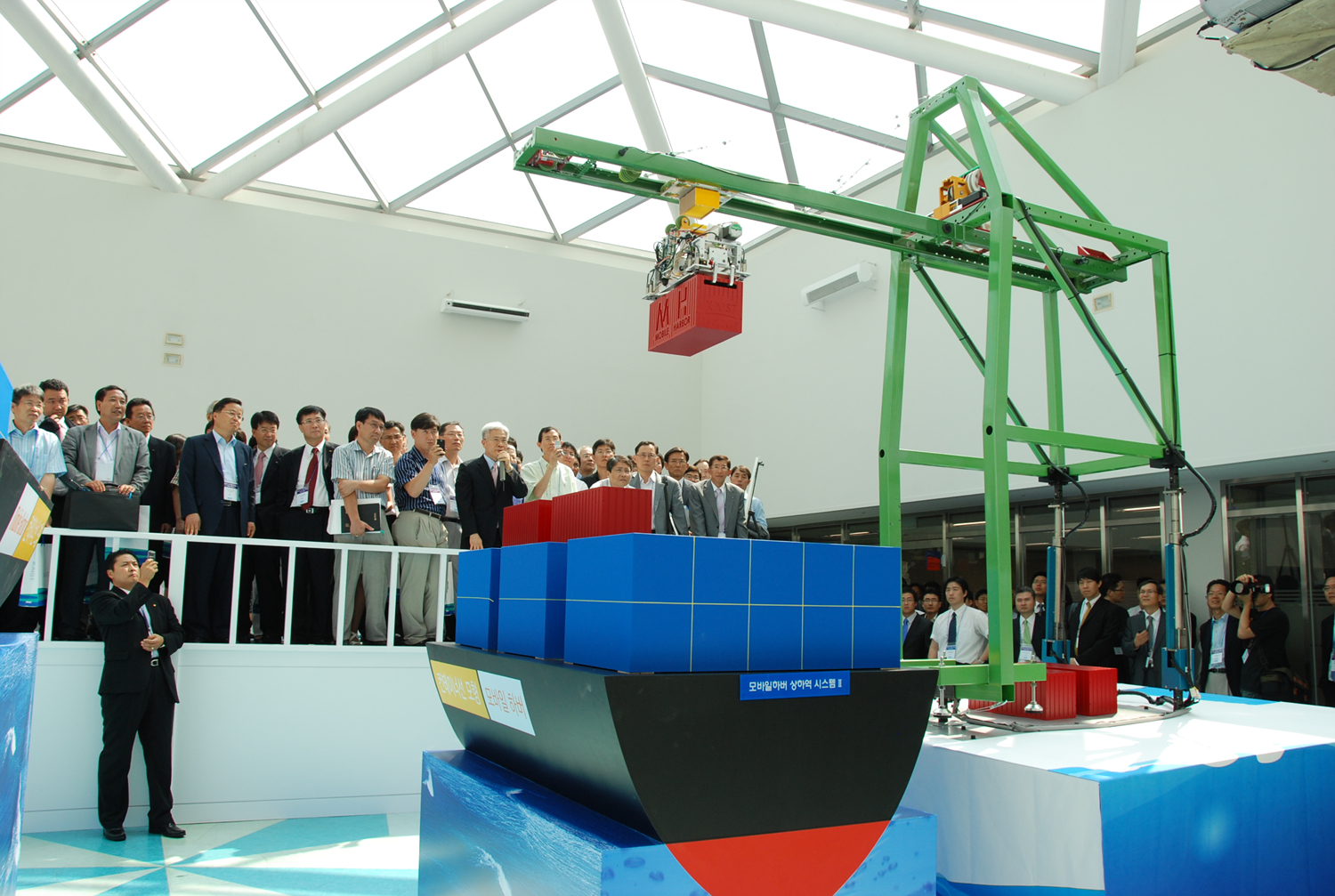 KAIST's Mobile Harbor Program Attracts Two Corporate Investments
KAIST-developed Mobile Harbor Program has attracted investments from Korea"s two big-name industrial corporations, university authorities said on Monday (Oct. 19).
KAIST has recently signed an agreement with Hyundai Wia Corp., a machine parts supplier, to collaborate in the researches of the mobile harbor programs and commercialization. Under the agreement, Hyundai WIA will invest a total of 7.5 billion won in the program for two years starting from January 2010.
KAIST has also received a letter of intent from the Daewoo Shipbuilding & Marine Engineering Co. on investing 20 billion won in the commercialization of the project.
The Mobile Harbor Program is designed to create mobile units that can go out to the ship which are anchored off-shore and unload the cargo and take it to where it is needed. It is aimed at overcoming the shortcomings of the current maritime container transportation systems. Container ships are getting larger and larger, requiring deep waters, large and complex loading and unloading systems, and major investments in facilities.
Prof. Byung-Man Kwak, leader of the program"s R&D team, said: "With the investment from two global industrial companies, the program has gained a crucial momentum. The development of the program is expected to help Korea to become a global leader in marine transportation and maintain its supremacy in shipbuilding."
2009.10.20 View 18271
KAIST's Mobile Harbor Program Attracts Two Corporate Investments
KAIST-developed Mobile Harbor Program has attracted investments from Korea"s two big-name industrial corporations, university authorities said on Monday (Oct. 19).
KAIST has recently signed an agreement with Hyundai Wia Corp., a machine parts supplier, to collaborate in the researches of the mobile harbor programs and commercialization. Under the agreement, Hyundai WIA will invest a total of 7.5 billion won in the program for two years starting from January 2010.
KAIST has also received a letter of intent from the Daewoo Shipbuilding & Marine Engineering Co. on investing 20 billion won in the commercialization of the project.
The Mobile Harbor Program is designed to create mobile units that can go out to the ship which are anchored off-shore and unload the cargo and take it to where it is needed. It is aimed at overcoming the shortcomings of the current maritime container transportation systems. Container ships are getting larger and larger, requiring deep waters, large and complex loading and unloading systems, and major investments in facilities.
Prof. Byung-Man Kwak, leader of the program"s R&D team, said: "With the investment from two global industrial companies, the program has gained a crucial momentum. The development of the program is expected to help Korea to become a global leader in marine transportation and maintain its supremacy in shipbuilding."
2009.10.20 View 18271 -
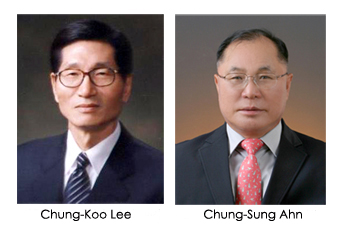 KAIST Appoints Two CEOs for Promotion of Innovative Projects
KAIST has appointed chief executive officers (CEO) for the two companies KAIST has recently established to carry out two innovative "low-carbon, green growth projects" supported by the Korean government, university authorities said on Monday (June 2).
Chung-Sung Ahn, a former executive of Hyundai Heavy Industries Co., a top shipbuilder of the world, was appointed as the CEO of the Mobile Harbor Co., and Chung-Koo Lee, a former president of Hyundai Motor Co., as CEO of the On-Line Electric Car Co.
The two companies have been newly established for the commercial operation of the mobile harbor and on-line electric car projects that KAIST has been working on.
KAIST has developed a plan to power electric cars through re-charging strips embedded in roadways. The university has built a prototype on its campus for electric-powered golf carts and worked on designs that would power cars and buses.
The mobile harbor system is motivated by a growing need for an innovative container transport service system to effectively meet continuing increase in global container shipping volume, KAIST has developed a system that can unload containers from a containership to a floating harbor in the sea and deliver them to a land terminal and load cargoes in a reverse way.
The 71-year-old Ahn of the Mobile Harbor Co. served as the president of the Offshore & Engineering Division and the Industrial Plant & Engineering Division of Hyundai Heavy Industries Co. from 2003 to 2005. He completed Advanced Management Program (AMP) from Harvard Business School in 1990. Ahn obtained Ph.D. in ocean engineering from MIT in 1972, M.S. in naval architecture from MIT in 1969, M.S. in meteorology/oceanography from MIT in 1967 and B.S. in Maritime Science from Korea Maritime University in 1959.
Chung-Koo Lee, 64, served as president of Hyundai Motor Co. from 1992 to 2002 and as a member of the Presidential Advisory Council on Science and Technology from 2001 to 2003.
2009.06.05 View 13073
KAIST Appoints Two CEOs for Promotion of Innovative Projects
KAIST has appointed chief executive officers (CEO) for the two companies KAIST has recently established to carry out two innovative "low-carbon, green growth projects" supported by the Korean government, university authorities said on Monday (June 2).
Chung-Sung Ahn, a former executive of Hyundai Heavy Industries Co., a top shipbuilder of the world, was appointed as the CEO of the Mobile Harbor Co., and Chung-Koo Lee, a former president of Hyundai Motor Co., as CEO of the On-Line Electric Car Co.
The two companies have been newly established for the commercial operation of the mobile harbor and on-line electric car projects that KAIST has been working on.
KAIST has developed a plan to power electric cars through re-charging strips embedded in roadways. The university has built a prototype on its campus for electric-powered golf carts and worked on designs that would power cars and buses.
The mobile harbor system is motivated by a growing need for an innovative container transport service system to effectively meet continuing increase in global container shipping volume, KAIST has developed a system that can unload containers from a containership to a floating harbor in the sea and deliver them to a land terminal and load cargoes in a reverse way.
The 71-year-old Ahn of the Mobile Harbor Co. served as the president of the Offshore & Engineering Division and the Industrial Plant & Engineering Division of Hyundai Heavy Industries Co. from 2003 to 2005. He completed Advanced Management Program (AMP) from Harvard Business School in 1990. Ahn obtained Ph.D. in ocean engineering from MIT in 1972, M.S. in naval architecture from MIT in 1969, M.S. in meteorology/oceanography from MIT in 1967 and B.S. in Maritime Science from Korea Maritime University in 1959.
Chung-Koo Lee, 64, served as president of Hyundai Motor Co. from 1992 to 2002 and as a member of the Presidential Advisory Council on Science and Technology from 2001 to 2003.
2009.06.05 View 13073 -
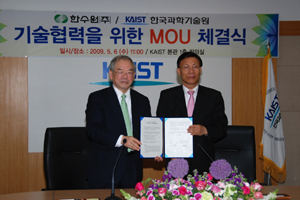 KAIST, KHNP Sign MOU on Nuclear Technology Development
KAIST signed a memorandum of understanding with the Korea Hydro & Nuclear Power Co. (KHNP) on Wednesday (May 6) to upgrade cooperation between the two organizations in nuclear power technology development.
On hand at the signing ceremony at KAIST were KAIST President Nam-Pyo Suh, KHNP President Jong-Shin Kim and other related officials.
The agreement calls for increased efficiency and synergy effect in the development of nuclear power generation by KAIST and KHNP to gain greater competitiveness in the exportation of nuclear power technologies.
KHNP is responsible for the operation of all nuclear and hydraulic power plants in Korea which supply about 40 percent of the nation"s electric power demand. It is the largest among the six power generating subsidiaries that separated from Korea Electric Power Corporation (KEPCO) in April 2001.
2009.05.07 View 13188
KAIST, KHNP Sign MOU on Nuclear Technology Development
KAIST signed a memorandum of understanding with the Korea Hydro & Nuclear Power Co. (KHNP) on Wednesday (May 6) to upgrade cooperation between the two organizations in nuclear power technology development.
On hand at the signing ceremony at KAIST were KAIST President Nam-Pyo Suh, KHNP President Jong-Shin Kim and other related officials.
The agreement calls for increased efficiency and synergy effect in the development of nuclear power generation by KAIST and KHNP to gain greater competitiveness in the exportation of nuclear power technologies.
KHNP is responsible for the operation of all nuclear and hydraulic power plants in Korea which supply about 40 percent of the nation"s electric power demand. It is the largest among the six power generating subsidiaries that separated from Korea Electric Power Corporation (KEPCO) in April 2001.
2009.05.07 View 13188 -
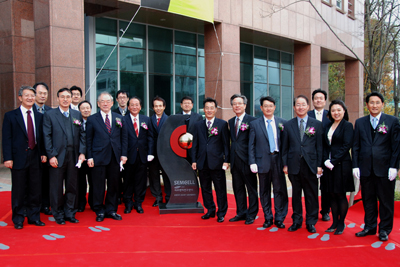 KAIST Opens Cell Bench Research Center
KAIST opened a cell bench research center on the campus on Monday, Nov. 17, as a joint project with Samsung Electric Co. and Samsung Medical Center.
On hand at the opening ceremony were about 100 persons from the three organizations, including KAIST President Nam-Pyo Suh, Samsung Electric"s Chief Technology Officer (CTO) Byung-Cheon Koh and Samsung Medical Center Vice President Hyo-Geun Lim.
The newly-opened research center will be involved in the development of individually-tailored anti-cancer medicine using bio-inspired cell chips and technologies for clinical applications. Prof. Young-Ho Cho of the Department of Bio and Brain Engineering was named director of the research center.
"Top-notch professionals from the electronic industry, academia and the medical community have gathered together to establish this research center. We expect the center will open a new path for the science and technology community and the industry to combine their strengths and develop innovative anti-cancer therapeutics," said KAIST President Nam-Pyo Suh at the opening ceremony.
"The development of bio-cell chip technology represents a new challenge for the Samsung Electric which has focused on information technologies thus far. Through cooperation with KAIST and Samsung Medical Center, we expect to be able to develop a simple and efficient cure for cancer patients," commented Samsung Electric CTO Byung-Cheon Koh.
The research center will be initially concentrating on the development of cell chips for lung cancer, one of the primary causes of death for Koreans.
2008.11.17 View 18731
KAIST Opens Cell Bench Research Center
KAIST opened a cell bench research center on the campus on Monday, Nov. 17, as a joint project with Samsung Electric Co. and Samsung Medical Center.
On hand at the opening ceremony were about 100 persons from the three organizations, including KAIST President Nam-Pyo Suh, Samsung Electric"s Chief Technology Officer (CTO) Byung-Cheon Koh and Samsung Medical Center Vice President Hyo-Geun Lim.
The newly-opened research center will be involved in the development of individually-tailored anti-cancer medicine using bio-inspired cell chips and technologies for clinical applications. Prof. Young-Ho Cho of the Department of Bio and Brain Engineering was named director of the research center.
"Top-notch professionals from the electronic industry, academia and the medical community have gathered together to establish this research center. We expect the center will open a new path for the science and technology community and the industry to combine their strengths and develop innovative anti-cancer therapeutics," said KAIST President Nam-Pyo Suh at the opening ceremony.
"The development of bio-cell chip technology represents a new challenge for the Samsung Electric which has focused on information technologies thus far. Through cooperation with KAIST and Samsung Medical Center, we expect to be able to develop a simple and efficient cure for cancer patients," commented Samsung Electric CTO Byung-Cheon Koh.
The research center will be initially concentrating on the development of cell chips for lung cancer, one of the primary causes of death for Koreans.
2008.11.17 View 18731 -
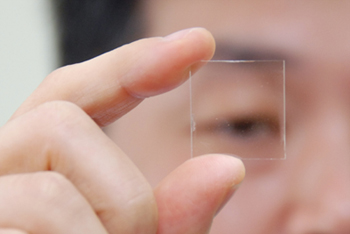 Home-Grown Transparent Thin Film Transistor Developed
KAIST, Aug. 6, 2008 -- A KAIST research team led by Profs. Jae-Woo Park and Seung-Hyup Yoo of the Electrical Engineering Division has developed a home-grown technology to create transparent thin film transistor using titanium dioxide., university authorities said.The KAIST team made the technological advance in collaboration with the LCD Division of Samsung Electronics and the Techno Semichem Co., a local LCD equipment maker. Transparent thin film transistor continues to enjoy a wealth of popularity and intensive research interest since it is used in producing operating circuits including transparent display, active-matrix OLED (AMOLED) display and flexible display.
The new technology is significant in that it is based on a titanium dioxide, the first such attempt in the world, while the technologies patented by the United States and Japan are based on ZnO.
Researchers will continue to work on securing technological reliability and developing a technology to mass-produce in a large-scale chemical vapor deposition equipment for the next couple of years.
"The development of technology to produce transparent thin film transistor will help Korean LCD makers reduce its dependence on foreign technologies, as well as maintain Korea"s status as a leader of the world"s display industry," said Prof. Park.
KAIST has applied for local patent registration of the technology and the process is expected to complete by this October or November. International patents have been also applied for in the U.S., Japan and Europe.
The new technology was introduced in the latest edition of the Electron Device Letters, a journal published by the Institute of Electrical and Electronics Engineers or IEEE, a New York-based international non-profit, professional organization for the advancement of technology related to electricity. It will be presented at the International Display Workshop 2008 on Dec. 5 in Niigata, Japan.
2008.08.07 View 17777
Home-Grown Transparent Thin Film Transistor Developed
KAIST, Aug. 6, 2008 -- A KAIST research team led by Profs. Jae-Woo Park and Seung-Hyup Yoo of the Electrical Engineering Division has developed a home-grown technology to create transparent thin film transistor using titanium dioxide., university authorities said.The KAIST team made the technological advance in collaboration with the LCD Division of Samsung Electronics and the Techno Semichem Co., a local LCD equipment maker. Transparent thin film transistor continues to enjoy a wealth of popularity and intensive research interest since it is used in producing operating circuits including transparent display, active-matrix OLED (AMOLED) display and flexible display.
The new technology is significant in that it is based on a titanium dioxide, the first such attempt in the world, while the technologies patented by the United States and Japan are based on ZnO.
Researchers will continue to work on securing technological reliability and developing a technology to mass-produce in a large-scale chemical vapor deposition equipment for the next couple of years.
"The development of technology to produce transparent thin film transistor will help Korean LCD makers reduce its dependence on foreign technologies, as well as maintain Korea"s status as a leader of the world"s display industry," said Prof. Park.
KAIST has applied for local patent registration of the technology and the process is expected to complete by this October or November. International patents have been also applied for in the U.S., Japan and Europe.
The new technology was introduced in the latest edition of the Electron Device Letters, a journal published by the Institute of Electrical and Electronics Engineers or IEEE, a New York-based international non-profit, professional organization for the advancement of technology related to electricity. It will be presented at the International Display Workshop 2008 on Dec. 5 in Niigata, Japan.
2008.08.07 View 17777 -
 CJIS donates development fund of two hundreds million won to KAIST
CJIS donates development fund of two hundreds million won to KAIST
CJ Investment & Securities Co., Ltd. (CJIS/ CEO Hong-Chang Kim) donated a development fund of two hundreds million won to KAIST (President Nam-Pyo Suh) on Monday, August 30 to contribute to the development of KAIST and its fostering of science genius.
At the donation ceremony held at the main conference room in KAIST main administration building, CJIS CEO Hong-Chang Kim said, “I am very pleased to contribute to the development of KAIST, which is developing into a world-class research university.” In response to this, KAIST president Nam-Pyo Suh said, “I am very grateful for CJIS’s support. I will do my best to make KAIST one of the world-class research universities to be the hub of the world as well as Korea in the field of the cutting-edge science and technology.”
2006.09.06 View 15952
CJIS donates development fund of two hundreds million won to KAIST
CJIS donates development fund of two hundreds million won to KAIST
CJ Investment & Securities Co., Ltd. (CJIS/ CEO Hong-Chang Kim) donated a development fund of two hundreds million won to KAIST (President Nam-Pyo Suh) on Monday, August 30 to contribute to the development of KAIST and its fostering of science genius.
At the donation ceremony held at the main conference room in KAIST main administration building, CJIS CEO Hong-Chang Kim said, “I am very pleased to contribute to the development of KAIST, which is developing into a world-class research university.” In response to this, KAIST president Nam-Pyo Suh said, “I am very grateful for CJIS’s support. I will do my best to make KAIST one of the world-class research universities to be the hub of the world as well as Korea in the field of the cutting-edge science and technology.”
2006.09.06 View 15952